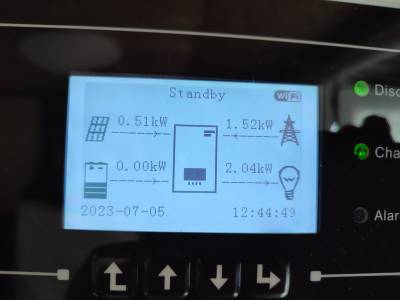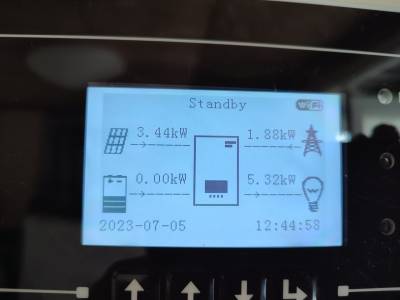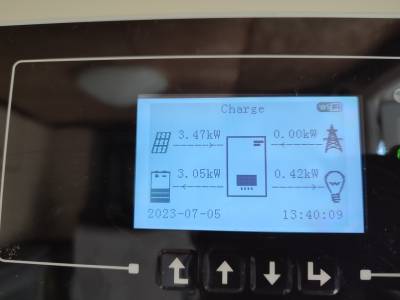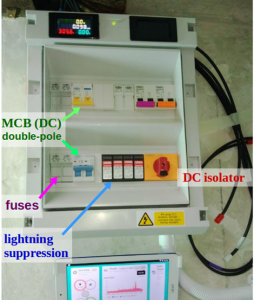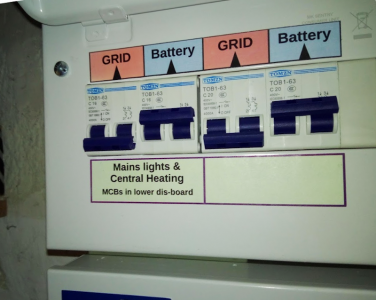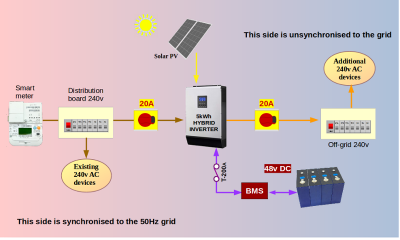Posted by: @misterbYou then have to use an additional CT clamp in parallel with the master ME3000.
I guess we should point back to https://renewableheatinghub.co.uk/forums/energy-storage/my-experience-with-the-selpos-mason-diy-kit/paged/5#post-17674
An update and to add to my confusion. I have identified the correct wires for the CT clamps now (I think) they are on the output live of the PV and on the live between the Consumer Unit and the smart meter
When I go through the start up process from the inverter, following every stage, this is the display
When I then turn on the kettle, the following display comes up, yet reverts back to the above display when the kettle is turned off? Why does the PV suddenly increase its priduction
I checked the battery and it didn't show that it was discharging, but the power has to have come from somewhere?
So. I then set about digging around my electricity cupboard and trying to think logically.... I changed the CT clamp onto a different cable, after spending time trying to identify and label everything as suggested previously ...
It looks as though everything is now working as it should. Thanks to everyone who helped/tried to help. It really was something simple as suggested right at the beginning
Posted by: @misterband on the live between the Consumer Unit and the smart meter
I don't yet understand what "between the Consumer Unit and the smart meter" precisely means; there should be the Henley Blocks but may also be the isolator in-between. I think you need to be house-side of an isolator (if present) but grid side of the Henley Blocks. You want to be able to stop the ME3000SP generating power when you switch the isolator to the off position (also pointing out the importance of labelling and making electricians aware that battery storage and PV is present in the house), hence the CT clamp should be house-side of the isolator.
For more power I think you might have to just upgrade your solar and battery setup with a nice hybrid inverter; something like a Sunsynk ECCO 5kW or 8.8kW would then simplify what you are getting permission for.
Posted by: @misterbi assume 6kw means not only can it output 6kw but i can also charge at 6kw?
Sorry, from the datasheet it looks as if the 6kW applies to maximum grid output. It is 3kW (max charge of 65A and discharge of 70A) on the battery side. It is fairly common to have different power limits, so read carefully!
Posted by: @misterbcould i then add additional solar at some stage without affecting the solar set up and FiT payments that i currently receive?
Aaah, you didn't mention FiT. I do not know the rules of the scheme, but I am guessing that running only the original equipment (or like-for-like replacements) will attract the payments.
Another option would be to use off-grid inverters and take the house (or parts thereof) off-grid. @transparent has done that with a pair of Growatt SPF5000ES (albeit as a bit of a systems integration lab).
Posted by: @chickenbigAnother option would be to use off-grid inverters and take the house (or parts thereof) off-grid. @transparent has done that with a pair of Growatt SPF5000ES
Well, I have more than a pair of Growatt SPF-series inverters.
And there's some bits you don't get to see in the photos I post online!
The SPF range of inverters are off-grid only. They have an internal 50Hz oscillator which prevents them from being able to synchronise with the grid.
I also have a Growatt MIN 3600XE PV string inverter. That's grid-tied only and could theoretically still export at 16A to earn income from FIT or SEG payments.
I have a couple of PV string-combiner boxes which allow me to switch the four rooftop PV arrays between the available inverters.
There are other manufacturers who offer PV inverters which can supply loads from either the grid, or from off-grid batteries in the absence of mains power.
I've taken time to research these, but not yet committed to buying-in half-a-dozen to test out.
My current analysis is that none of these can offer all of the features I'd like to see.
So there are compromises to be made.
My present investigations are in the area of system resilience.
If a battery unit or an inverter has a fault, does the rest of the system remain live and effective?
The short answer is "No"!
... so that requires some smart controller to intervene and de-couple a device with a fault-code that can be detected.
Posted by: @misterbi want to make full use of the off peak period 0030-0430 that i currently have, to harvest as much energy as i can
That's a good starting point.
It tells us that you're using the Octopus Go tariff.
But:
- Have you yet realised that your cheap-rate period doesn't actually coincide with 0030-0430? Smart Meters have an internal Randomised Offset, up to 1799 secs, to prevent grid surges.
- You need to (manually) check the forecast for the next day. You don't want to take so much from the grid at night that you end up unable to store free energy from solar the next day!
- Cheap-rate overnight tariffs will soon give way to Nodal-pricing. Night-time will suffer heavy demand for charging EVs
The whole subject of electricity storage is in a period of flux.
Some components we'd like to have are not yet designed, let alone manufactured.
We are also up against commercial vendors who would like you buy in to their strategy, many of which have a 'lock-in' by which you rely on commands being sent to your 'Smart battery' or 'Smart charger' only from their proprietary in-house computer.
Save energy... recycle electrons!
thanks for the info. as a newbie i am trying to as much research as i can and appreciate your responses.
so from what i have read on here and via the net, the max charge i can expect from the grid looks to be around 3kw/h. so my 'desire' to charge @25kw (28.8 - 10%) over 4 hour off peak really wont work.
so at the moment you seem to suggest it doesnt seem to make sense to buy another 14.3kw battery, although it might be possible to charge 25kw over the summer (using pv) as i only use around .5kw per hour with the house at normal operation tv, fridges. lights etc it just wouldnt be cost effective unless i could charge from the mains at a higher charge than 3kw/hour.
we are on the octopus go tariff as we have storage heaters (dimplex quantums, so a lot more energy efficient than the old type) plus we also run a mini split air con/heating unit in the winter to heat up the kitchen/dining conservatory. i was sort of hoping that i could harvest the energy into the larger battery to run that? i also fitted the pipework for an under floor heating system to the kitchen/dining conservatory with the intent at some stage to consider a small heat pump to provide UHF to those areas.
going back to ne of my earlier posts, if i did run two inverters side by side, would that give me the potential of then being able to put 3kw per hour into two batteries? i understand there might be an issue if one battery does all the work, but could i just rotate the batteries every week or so? i dont need to draw more than 3kw per hour out of the batteries but would like to be able charge up and use 20+kw per day which is what i easily use in the winter months
Posted by: @misterbwe are on the octopus go tariff as we have storage heaters (dimplex quantums, so a lot more energy efficient than the old type) plus we also run a mini split air con/heating unit in the winter to heat up the kitchen/dining conservatory. i was sort of hoping that i could harvest the energy into the larger battery to run that?
I guess there is nothing to stop you moving the large loads (or even all loads) onto an off-grid system, for instance several Growatt SPF5000ES running in parallel. Do make sure you hire an electrician competent in earthing the system correctly; if the grid disconnects then you can't rely on the DNO provided earth (see islanding). I did make this suggestion to @batalto when he wanted to augment his solar PV system without relying on the DNO, but he felt the bother would be too great. If you are concerned about the reliability of several inverters running in a system (which may not have desirable properties if the communication between them is some sort of daisy-chain), you could always add a manual transfer switch (presumably simple and so fairly reliable) to put your loads back on the grid.
Posted by: @misterbwe are on the octopus go tariff
One thing to double check before you go off planning is whether you are able to go on Octopus Intelligent instead - that gives you 6 hrs (11:30-5:30), and a cheaper rate. You need either a compatible EV, or a compatible charger (Ohme pretty much at the moment) to use it.
That would give you 18kWh on your current set up, or for example 30kWh on a 5kW Hybrid.
You sort of need to plan all this if you are going to do it, as you don't really want to be chopping and changing DNO applications I guess? Up here on Northern Powergrid a >3.6kW application is £650.
Personally, I would see how your current system does over Summer and Winter, and make a decision then if it's all installed and working now. Even with cheap DIY battery boxes if you don't often use a large amount of kWh then the saving can be marginal if you get multiple boxes. You can already shift your storage heaters overnight for example without any battery need.
I think a 5kW Sunsynk is a nice sweet spot, we rarely go over 5kW and that's because I've forgotten and put the dishwasher and washing machine on at the same time as the oven...I just go an pause the washing machine until finished cooking.
thanks, moving the storage heaters onto a separate off grid system wasn't anything that had even entered my thought process ...
Posted by: @chickenbigyou could always add a manual transfer switch (presumably simple and so fairly reliable) to put your loads back on the grid.
Like this:
That photo shows two double-pole changeover trips in my off-grid consumer unit.
The left one is rated 16A (C-curve) and allows my central-heating and (4) lighting circuits to be switched between grid-tied and off-grid.
The C20 unit is a 'spare'.
See later post in which I provide a link for a much cheaper and narrower Manual Transfer Switch.
Posted by: @misterbthe max charge i can expect from the grid looks to be around 3kw/h. so my 'desire' to charge @25kw (28.8 - 10%) over 4 hour off peak really wont work.
Erm, I disagree.
That 3kW constraint is being imposed by you using a Sofar storage controller/inverter.
Haven't we already concluded that you'll be adding further inverters to enhance your off-grid capabilities?
Most inverters are rated around 5kW, and many can be used in parallel.
That 5kW just happens to be a sweet-spot which allows manufacturers to provide units with reasonably attractive characteristics and prices.
Above that point the design needs more expensive mosFET transistors, and a heavier transformer.
It will also generate more heat when operating at high-currents, so fan-noise becomes a problem.
Finally @misterb... you are no longer allowed to refer to yourself as a 'newbie'. 😉
Over the past week, you've amassed more knowledge on this subject than 99% of the population will ever achieve!
Your new 'mission' is to go out and tell as many people as you can all about electricity storage in the home.
We're unlikely to ever recover from last year's hike in energy prices, so you can expect a ready audience who would be prepared to install batteries.
If you don't spread the word about the quasi-DIY approach, those consumers will become prey to a plethora of unscrupulous vendors, prepared to sell them tiny (4kW) batteries at high prices.
That's going to take them a decade or more to reach the point of viability.
The diagram below is a simplified overview of the concepts being discussed here.
As such it's a good conversation-opener.
The precise numbers used in the labels are there to provoke a discussion.
Few people will actually install a 20A rotary switch or a 200A fuse between inverter and battery.
But it enables others to get an idea of the size/type of component parts we're looking for.
Save energy... recycle electrons!
@vaugi thanks, having too many appliances on at any one time is something we are very much aware of when in the motorhome with a 304Ah lithium battery, renogy 3kw inverter and 200w of solar ! we can have the microwave and kettle on together, which was the main criteria and can be truly off grid for a few days without driving to charge the batteris
- 26 Forums
- 2,406 Topics
- 54.6 K Posts
- 390 Online
- 6,092 Members
Join Us!
Worth Watching
Latest Posts
-

RE: Replacing my 18 month old Hitachi Yutaki ASHP
A big thank you to @jamespa for all his efforts online ...
By trebor12345 , 12 minutes ago
-
Daikin DHW Margin - what is it?
Our Daikin Altherma 3 Monoblock has DHW settings for bo...
By Pipcart , 33 minutes ago
-
RE: Considering MLCP (Multi-Layer Composite Pipe) for ASHP
@deltona I did draft a long point by point response ...
By JamesPa , 36 minutes ago
-

RE: GSHP WOES! Midland based engineer recommendations?
@editor It is indeed for servicing. My current service ...
By Morgan , 1 hour ago
-
RE: Recommended home battery inverters + regulatory matters - help requested
@transparent Thanks, I think I now get it. I am sor...
By JamesPa , 1 hour ago
-
RE: Sunsynk Whole House Backup Issue
Hi @lostandconfused , I agree that topic/thread is the ...
By Batpred , 1 hour ago
-
RE: Speedcomfort radiator fans
In case it helps Andrew Kuhne on openenergy monitor has...
By JamesPa , 2 hours ago
-

RE: Post-Traumatic Heat Pump Stress Disorder
@jamespa, we have got this topic, which all the mods ca...
By Mars , 4 hours ago
-

Things have gone quiet with you @drei. Any updates?
By Mars , 5 hours ago
-

RE: Passiv Smart Thermostat - Help & Forum Support
Thanks @tim441. Interesting timing, as Passiv are a cur...
By Mars , 7 hours ago
-
Hi everyone, I have a two year old Marlec Solar iBoos...
By Tallmarc , 9 hours ago
-
RE: Please help with the settings ecodan
Are you trying to address any particular performance is...
By Sheriff Fatman , 15 hours ago
-
RE: Solis inverters S6-EH1P: pros and cons and battery options
🤣 Well, I never managed to get the HA solis "...
By Batpred , 16 hours ago
-
RE: Experience - New Build / Complete New Heating System
Your sap clculations should give you a heat loss figure...
By JohnnyB , 17 hours ago
-
RE: Vaillant aroTherm not heating with many faults
@editor hmmm, our engineers Rae, Craig, Naz, Rob and Ry...
By ASHP-BOBBA , 17 hours ago
-
RE: I’m glad the cold spell is over!
@editor as a reply for this date the 6th of Jan in o...
By Nursethescreens , 19 hours ago
-
RE: Heat loss based on gas usage
@jamespa Thanks. The numbers posted above were jus...
By Bash , 19 hours ago
-
RE: Heat pump not reaching flow temperature
I would describe this as either a fault or a configurat...
By JamesPa , 20 hours ago

